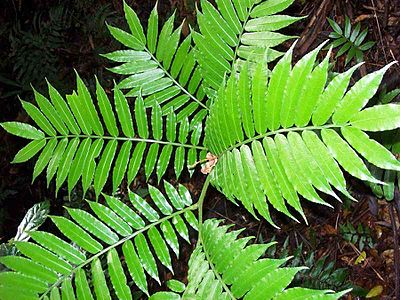
Wikipedia description
Angiopteris evecta, commonly known as the giant fern, is a rare plant occurring in eastern and northern Australia and the Malay Peninsula. Also found growing in nearby islands such as Borneo, Sumatra, New Guinea and various places in Polynesia, Melanesia and Madagascar. Listed as endangered in New South Wales, where it has been recorded growing in sub tropical rainforest, in the valley of the Tweed River. It is an invasive species in Hawaii and Jamaica.
Angiopteris evecta is the type species of the genus Angiopteris. It was originally described as Polypodium evectum by Georg Forster in 1786, before being reclassified and given its current binomial name in 1796 by Georg Franz Hoffmann. The species name is the Latin adjective evectus "swollen" or "inflated", probably a reference to its huge, bulbous pulvini. Common names include giant fern, king fern, oriental vessel fern, and mule's foot fern. In the Malay speaking nations ( Indonesia , Malaysia , Singapore, Brunei and Timor Leste ) it is called "Paku Gajah" (Elephant Fern).
The huge mature fronds measure up to 9 metres (29.5 ft) long. These largest ones are apparently found in Queensland where the lamina or blade can be up to 23 feet (7 meters) in length with the petiole or stalk being an additional 6' 6" (2 meters) long. 29' 6" (9 meter) fronds have also been reported for the variety A. e. teysmanniana in Java. The succulent petioles, again in Queensland, can be up to four in (10 cm) thick, and in the variety A e. microura of the Solomon Islands the petiole can be up to 8' 9" (2.7 meters) in length, joined to the trunk or caudex by a pulvinus which can be up to 8 in (20 cm) thick that serves to raise and lower the frond in response to weather conditions. This is the largest pulvinus of any known plant. At the base of each frond, surrounding the pulvinus like two catcher's mits, is a pair of fleshy stipules. A plant of the variety A. e palmiformis, native to the Philippines but growing at the Lyon Arboretum, Oahu, Hawai'i in June 1987 had stipules up to 9.25 inches (23.5 cm) long by 5.75 inches (14.6 cm) wide. These are the largest stipules of any known plant. The fronds originate from a large thick rootstock, or caudex typically up to 150 cm (60 in) high, but occasionally as much as ten feet (3 meters) in height., and up to 3.25 feet (one meter) or perhaps even 6' 7" (2 meters) in thickness. An individual with 29' 6" (9 meter) fronds emerging from a caudex 18 inches (45 cm) thick could potentially have a crown spread of 61 feet (18.6 meters), the greatest of any tree fern.
Angiopteris evecta can be grown in well-drained moist sites in the garden with some shade. It is very difficult to propagate by spores but the stipules from the frond base can be removed and will form a new plant in around a year in a medium of sand and peat.
Scientific classification
Samples